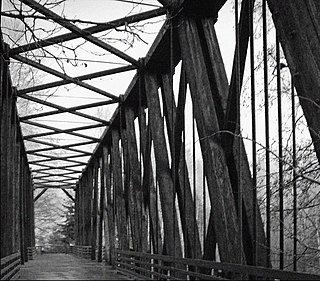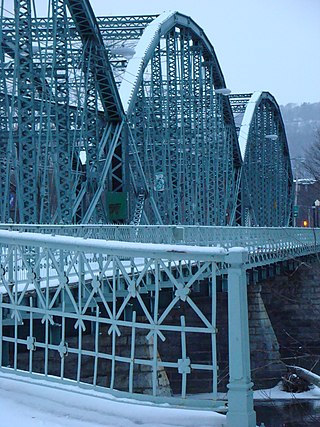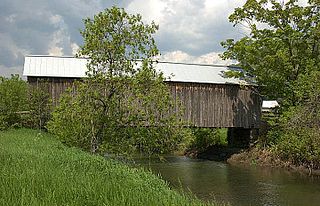
A truss bridge is a bridge whose load-bearing superstructure is composed of a truss, a structure of connected elements, usually forming triangular units. The connected elements may be stressed from tension, compression, or sometimes both in response to dynamic loads. The basic types of truss bridges shown in this article have simple designs which could be easily analyzed by 19th and early 20th-century engineers. A truss bridge is economical to construct because it uses materials efficiently.

The Ada Covered Bridge is a 125-foot (38 m) span Brown truss covered bridge erected in 1867 in Ada, Michigan, United States. Carrying Bronson Street across the Thornapple River, it is located just south of where the Thornapple enters the Grand River, in turn just south of M-21. It is listed on the National Register of Historic Places.

Fallasburg Bridge is a 100-foot (30 m) span Brown truss covered bridge, erected in 1871 in Vergennes Township, Michigan, United States, 5 miles (8.0 km) north of Lowell on the Flat River. Carrying Covered Bridge Road across the Flat, it is located in the Fallasburg Historical District south of Whites Bridge and Smyrna. It is listed on the National Register of Historic Places, and along with Whites Bridge, Langley Covered Bridge, and Zehnder's Holz Brucke, is one of only four Michigan covered bridges open to vehicle traffic.

A Howe truss is a truss bridge consisting of chords, verticals, and diagonals whose vertical members are in tension and whose diagonal members are in compression. The Howe truss was invented by William Howe in 1840, and was widely used as a bridge in the mid to late 1800s.

Shushan Bridge is a covered bridge over the Batten Kill in the hamlet of Shushan in Washington County, New York, near Vermont. It is one of 29 surviving historic covered bridges in New York State, and one of 4 surviving in Washington County.

Buskirk Bridge is a wooden covered bridge and is the name of the hamlet in which it is located. It is in the town of Hoosick. The bridge, which crosses the Hoosic River is one of 29 historic covered bridges in New York State. The bridge takes its name from the nearby hamlet of the same name, which was named after the local Van Buskirk family.

Eagleville Bridge is a covered bridge located at Eagleville in the towns of Jackson and Salem, Washington County, New York. The bridge, which crosses the Battenkill, is one of 29 historic covered bridges in New York State.

The Grant Mills Bridge, officially the Millbrook Bridge, is a wooden covered bridge over Mill Brook in Hardenburgh, New York, United States. It is one of 29 covered bridges in the state.

Beaverkill Bridge, also known as Conklin Bridge, is a wooden covered bridge over the Beaver Kill north of the hamlet of Roscoe in the Town of Rockland, New York, United States, that carries Conklin Road through Beaverkill State Campground. It was erected in 1865, one of the first bridges over the river in what was then still a largely unsettled region of the Catskill Mountains.

William Howe was an American architect and bridge builder famous for patenting the Howe truss design for bridges in 1840.

The Dungeness River Bridge is the centerpiece of Railroad Bridge Park near the town of Sequim, Washington. It crosses the Dungeness River. The bridge was first constructed by the Seattle, Port Angeles, and Western Railway, a subsidiary of the Chicago, Milwaukee, St. Paul and Pacific Railroad in 1916. Because of the ready availability of timber, the bridge was built of wood. This first bridge was replaced in 1930. The new bridge was also built of timber, and like its predecessor, is a through Howe truss 156 feet long and 22 feet high. Two wooden trestles are on the east and west approaches.

Shaw Bridge, also known as Double-Span Whipple Bowstring Truss Bridge, is a historic bridge in Claverack, New York, United States. It carried Van Wyck Lane over Claverack Creek, but is now closed to all traffic, even pedestrians. It is "a structure of outstanding importance to the history of American engineering and transportation technology." Specifically designed by John D. Hutchinson, the bridge employs the basic design of Squire Whipple. It is the only extant "double" Whipple bowstring truss bridge in the U.S., having two identical spans placed in series over a common pier.

Campbell's Covered Bridge is a wooden covered bridge in northeastern Greenville County, South Carolina, near the small town of Gowensville, and crosses Beaverdam Creek off Pleasant Hill Road.

Bull's Bridge is a single-lane vehicular wooden covered bridge across the Housatonic River in the town of Kent, Connecticut, close to the state border with New York. The first instance of a bridge at this location was constructed by Jacob and Isaac Bull in 1760, which gave the bridge its name. Popular legend suggests that George Washington crossed the bridge with the Bulls' assistance while still under construction. The current bridge was built in 1842 from timber, with additional supports added in the 19th and 20th centuries. Built with a Town lattice design, the bridge has reinforced trusswork visible on the interior. At the time of its nomination to the National Register of Historic Places the roof had wood shingles. It is historically significant as one of three surviving covered bridges in Connecticut, and was listed on the National Register of Historic Places in 1972.

South Washington Street Parabolic Bridge is a historic Lenticular truss bridge located at Binghamton in Broome County, New York. It was constructed in 1886 and spans the Susquehanna River. It is composed of three identical through trusses with an overall length of 484 feet. The bridge was closed to vehicular traffic in 1969. It is the longest multiple span, Lenticular truss bridge constructed in New York State during the 19th century. It was constructed by the Berlin Iron Bridge Company of East Berlin, Connecticut. It was listed on the National Register of Historic Places in 1978. The bridge was rehabilitated between 2014 and 2017.

The bridge is significant locally as the only Pratt through-truss bridge remaining in Kosciusko County, and is important regionally as one of the few surviving spans built by the Bellefontaine Bridge and Iron Company.

Starke County Bridge No. 39 is a single span Warren Pony Truss structure. The bridge is located on the northern outskirts of the small town of Knox, Indiana, where Main and Water Streets terminate at the former Penn Central Railroad cut. The bridge spans the rail cut in a northwest–southeast direction, allowing access to Wythougan Park.

The Howe Covered Bridge is a historic covered bridge carrying Belknap Brook Road across the White River in Tunbridge, Vermont, just east of Vermont Route 110. Built in 1879, it is one of five surviving bridges in the town, one of the highest concentrations of covered bridges in the state. It was listed on the National Register of Historic Places in 1974.

The East Shoreham Covered Railroad Bridge is a historic covered bridge spanning the Lemon Fair River near East Shoreham, Vermont. Built in 1897 by the Rutland Railroad Company, it is the state's only surviving example of a wooden Howe truss railroad bridge. It was listed on the National Register of Historic Places in 1974.

The New Hampton Pony Pratt Truss Bridge is a historic pony Pratt truss bridge on Shoddy Mill Road in New Hampton of Lebanon Township, Hunterdon County, New Jersey. It crosses the Musconetcong River between Lebanon Township, Hunterdon County and Washington Township, Warren County. It was designed by Francis C. Lowthorp and built in 1868 by William Cowin of Lambertville, New Jersey. The bridge was added to the National Register of Historic Places on July 26, 1977 for its significance in engineering, industry and transportation. It is one of the few early examples of iron Pratt truss bridges remaining in the United States. It was later documented by the Historic American Engineering Record in 1991. It was added as a contributing property to the New Hampton Historic District on April 6, 1998.























